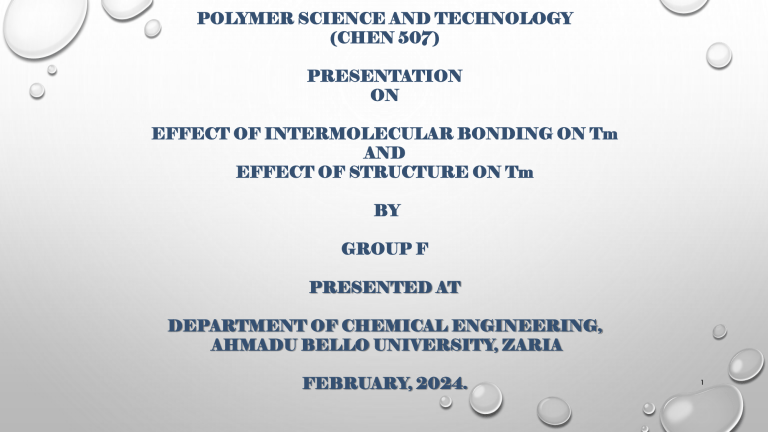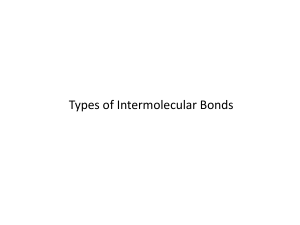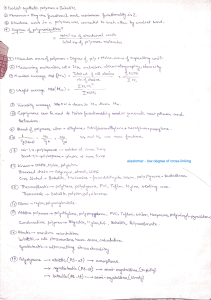
POLYMER SCIENCE AND TECHNOLOGY (CHEN 507) PRESENTATION ON EFFECT OF INTERMOLECULAR BONDING ON Tm AND EFFECT OF STRUCTURE ON Tm BY GROUP F PRESENTED AT DEPARTMENT OF CHEMICAL ENGINEERING, AHMADU BELLO UNIVERSITY, ZARIA FEBRUARY, 2024. 1 OUTLINE INTRODUCTION POLYMERS EFFECT OF INTERMOLECULAR BONDING IN POLYMERS EFFECT OF STRUCTURE ON TM IN POLYMER MATERIALS CONCLUSION REFERENCE 2 INTRODUCTION Tm polymer is the temperature at which a solid plastic material changes into a softer, flexible form or a solid amorphous form. The conversion occurs because the bond holding the plastic due to intermolecular force becomes loose or breaks down. Molecular structure in polymer materials refers to the arrangement of monomer units within polymer chains and the spatial organization of polymer chains in the solid state. 3 POLYMERS Polymers is larger molecule (macromolecule) built up by the repetition of small chemical units Monomer is defined as any molecule that can be converted by combining with other molecules of the same or different type. 4 REACTION OF MONOMERS 5 TYPES OF INTERMOLECULAR BONDING IN POLYMERS PRIMARY BONDS A. IONIC B. COVALENT C. METALLIC SECONDARY BONDS A. DIPOLE B. HYDROGEN C. INDUCTION D. VAN DER WAALS (DISPERSION) 6 COUN’T VAN DER WAALS FORCES: These forces arise from temporary fluctuations in electron density along polymer chains and between adjacent chains. They include dispersion forces and dipole-dipole interactions. HYDROGEN BONDING: Some polymers, such as polyamides (nylons) and polyesters, contain functional groups capable of forming hydrogen bonds. These bonds enhance intermolecular interactions and may increase Tm. 7 INFLUENCE ON TM 8 COUN’T The polymer melting point Tm is increased if the double bonds, aromatic groups, bulky or large side groups are present in the polymer chain because they restrict the flexibility of the chain. The branching of chains causes the reduction of melting point, as defects are produced because of the branching. 9 C0UN’T The strength and type of intermolecular bonding in polymers significantly impact their Tm. Polymers with strong intermolecular bonds, such as hydrogen bonds in nylon, generally have higher Tm values because more energy is required to overcome these bonds and transition from the solid to the liquid state. Polymers with weaker intermolecular forces, such as low-density polyethylene (LDPE), have lower Tm values because the intermolecular bonds are easier to break. 10 COUN’T 11 FACTORS AFFECTING THE CRYSTALLINE MELTING POINT, TM Intermolecular Bonding The decrease in the cohesive energy density associated with the decrease in the density of sites of or intermolecular bonding(increase space btw polar group) leads to a reduction in the melting points. Effect of Structure A high structural regularity that permits close packing of the chains couple with the initial chain flexibility leads to an unexpectedly high Tm Chain Flexibility Polymers with rigid chains would be expected to have higher Tm than those with flexible molecules. Copolymerization The effect of copolymerization on Tm depends on the degree of compatibility of the comonomer. 12 13 14 CONCLUSION Both intermolecular bonding and molecular structure significantly impact the Tm of polymer materials Stronger intermolecular bonds, such as hydrogen bonding, lead to higher Tm values Structural factor like chain length and copolymer also influence Tm 15 REFERENCES • Polymer science and technology robert o. Ebewele • Https://chat.Openai.Com/c/fce1e557-7c09-491f-a22c293caf4de643 • Chain length effect in polymer structure - search (bing.Com) 16 THANK YOU FOR LISTENING! 17

